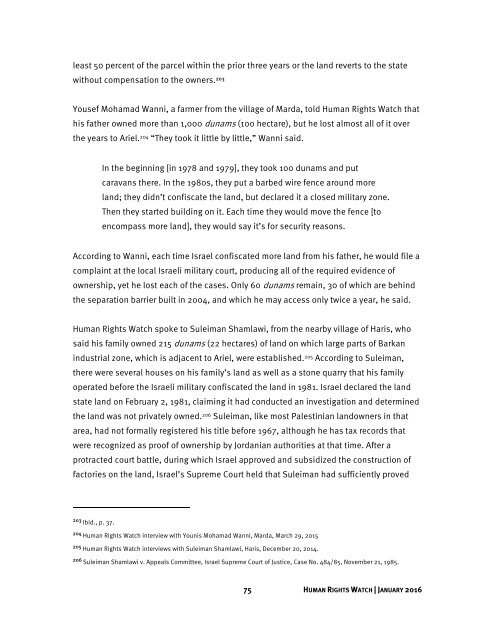OCCUPATION INC
israel0116_web
israel0116_web
Create successful ePaper yourself
Turn your PDF publications into a flip-book with our unique Google optimized e-Paper software.
least 50 percent of the parcel within the prior three years or the land reverts to the state<br />
without compensation to the owners. 203<br />
Yousef Mohamad Wanni, a farmer from the village of Marda, told Human Rights Watch that<br />
his father owned more than 1,000 dunams (100 hectare), but he lost almost all of it over<br />
the years to Ariel. 204 “They took it little by little,” Wanni said.<br />
In the beginning [in 1978 and 1979], they took 100 dunams and put<br />
caravans there. In the 1980s, they put a barbed wire fence around more<br />
land; they didn’t confiscate the land, but declared it a closed military zone.<br />
Then they started building on it. Each time they would move the fence [to<br />
encompass more land], they would say it’s for security reasons.<br />
According to Wanni, each time Israel confiscated more land from his father, he would file a<br />
complaint at the local Israeli military court, producing all of the required evidence of<br />
ownership, yet he lost each of the cases. Only 60 dunams remain, 30 of which are behind<br />
the separation barrier built in 2004, and which he may access only twice a year, he said.<br />
Human Rights Watch spoke to Suleiman Shamlawi, from the nearby village of Haris, who<br />
said his family owned 215 dunams (22 hectares) of land on which large parts of Barkan<br />
industrial zone, which is adjacent to Ariel, were established. 205 According to Suleiman,<br />
there were several houses on his family’s land as well as a stone quarry that his family<br />
operated before the Israeli military confiscated the land in 1981. Israel declared the land<br />
state land on February 2, 1981, claiming it had conducted an investigation and determined<br />
the land was not privately owned. 206 Suleiman, like most Palestinian landowners in that<br />
area, had not formally registered his title before 1967, although he has tax records that<br />
were recognized as proof of ownership by Jordanian authorities at that time. After a<br />
protracted court battle, during which Israel approved and subsidized the construction of<br />
factories on the land, Israel’s Supreme Court held that Suleiman had sufficiently proved<br />
203 Ibid., p. 37.<br />
204 Human Rights Watch interview with Younis Mohamad Wanni, Marda, March 29, 2015<br />
205 Human Rights Watch interviews with Suleiman Shamlawi, Haris, December 20, 2014.<br />
206 Suleiman Shamlawi v. Appeals Committee, Israel Supreme Court of Justice, Case No. 484/85, November 21, 1985.<br />
75 HUMAN RIGHTS WATCH | JANUARY 2016


